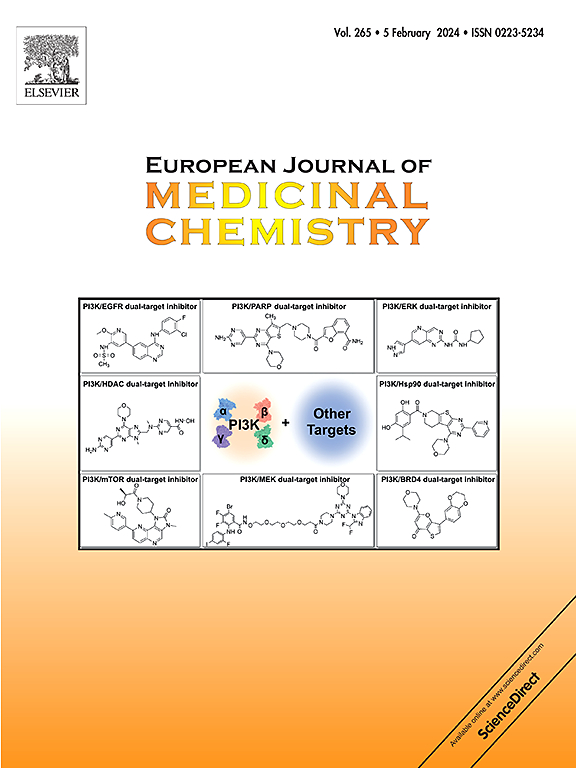Design, synthesis and biological evaluation of N-substituted nipecotamide derivatives as multifunctional agents for epilepsy treatment
IF 6
2区 医学
Q1 CHEMISTRY, MEDICINAL
引用次数: 0
Abstract
To discover novel multi-functional antiepileptic agents, nipecotamide was hybridized with salicylaldehyde, paeonol, vanillin and cinnamaldehyde to generate a series of N-substituted nipecotamide derivatives. Biological screening revealed that compound 11c exhibited remarkable scavenging activities against ABTS (2,2'-Azinobis-(3-ethylbenzthiazoline-6-sulfonic acid) ) radical (scavenging IC50: 92.0 μM), DPPH (1,1-Diphenyl-2-picrylhydrazyl) radical (scavenging IC50: 70.9 μM), and superoxide anion radical (inhibition percentage: 48.4%). Additionally, electrophysiological results showed that compound 11c demonstrated potent inhibitory effects on abnormal electrical discharges. Furthermore, compound 11c displayed the capacity to relieve H2O2-induced oxidative damage and LPS-induced neuroinflammation at the cellular level. Besides, compound 11c could cross the blood-brain barrier, alleviate the symptoms of epilepsy induced by pentylenetetrazole and pilocarpine effectively, and mitigate oxidative damage caused by sodium nitrite in mice. Therefore, compound 11c possesses symptomatic-treatment and disease-modification properties for epilepsy. These results highlighted that compound 11c was a highly promising candidate for further development as an antiepileptic agent.

n -取代尼培他胺衍生物多功能癫痫药物的设计、合成及生物学评价
为了发现新的多功能抗癫痫药物,我们将尼培他胺与水杨醛、丹皮酚、香兰素和肉桂醛杂交,合成了一系列n取代尼培他胺衍生物。生物筛选表明,化合物11c对ABTS(2,2′- azinobis -(3-乙基苯并噻唑-6-磺酸))自由基(清除IC50: 92.0 μM)、DPPH(1,1-二苯基-2-picrylhydrazyl)自由基(清除IC50: 70.9 μM)和超氧阴离子自由基(抑制率:48.4%)具有显著的清除活性。此外,电生理结果表明,化合物11c对异常放电有较强的抑制作用。此外,化合物11c在细胞水平上显示出减轻h2o2诱导的氧化损伤和lps诱导的神经炎症的能力。此外,化合物11c能穿越血脑屏障,有效缓解戊四唑和匹罗卡品所致的癫痫症状,减轻亚硝酸钠对小鼠的氧化损伤。因此,化合物11c对癫痫具有对症治疗和改善疾病的特性。这些结果表明,化合物11c作为抗癫痫药物具有很大的开发潜力。
本文章由计算机程序翻译,如有差异,请以英文原文为准。
求助全文
约1分钟内获得全文
求助全文
来源期刊
CiteScore
11.70
自引率
9.00%
发文量
863
审稿时长
29 days
期刊介绍:
The European Journal of Medicinal Chemistry is a global journal that publishes studies on all aspects of medicinal chemistry. It provides a medium for publication of original papers and also welcomes critical review papers.
A typical paper would report on the organic synthesis, characterization and pharmacological evaluation of compounds. Other topics of interest are drug design, QSAR, molecular modeling, drug-receptor interactions, molecular aspects of drug metabolism, prodrug synthesis and drug targeting. The journal expects manuscripts to present the rational for a study, provide insight into the design of compounds or understanding of mechanism, or clarify the targets.

 求助内容:
求助内容: 应助结果提醒方式:
应助结果提醒方式:


